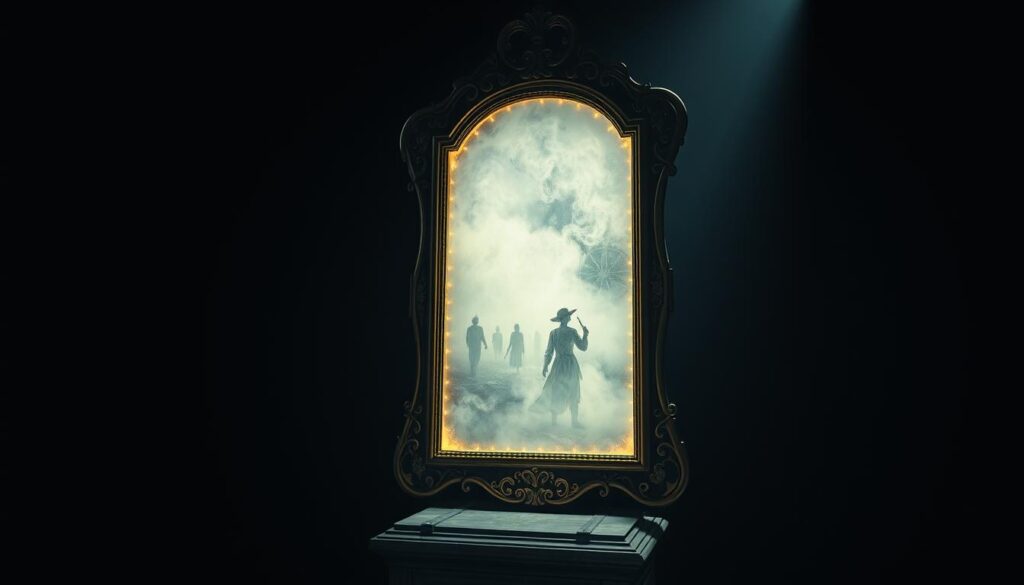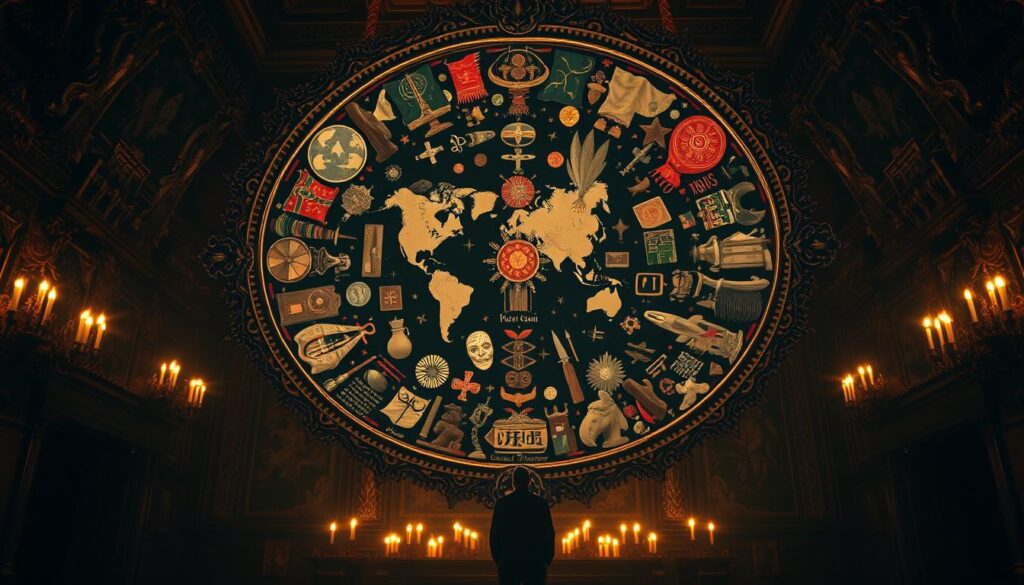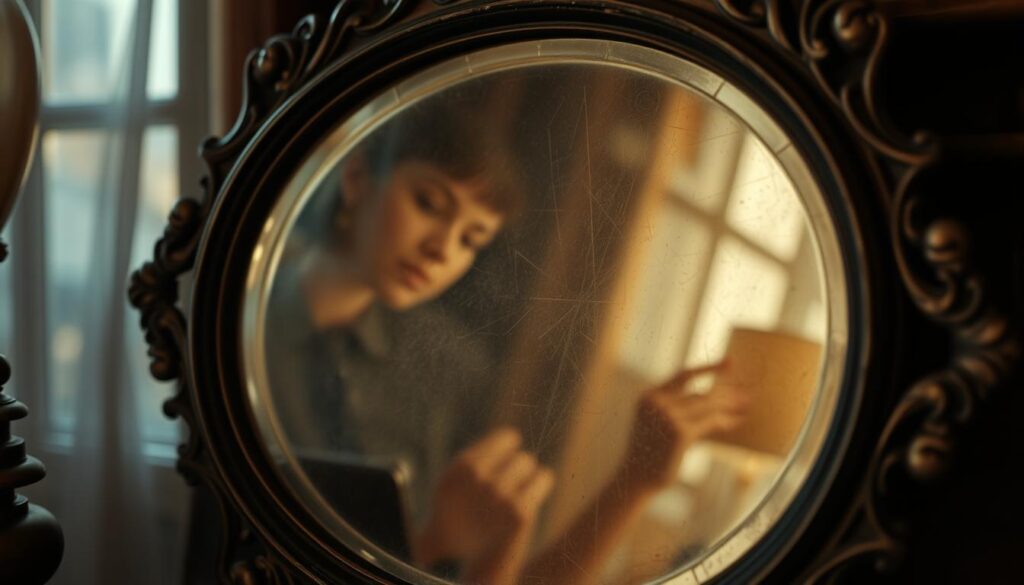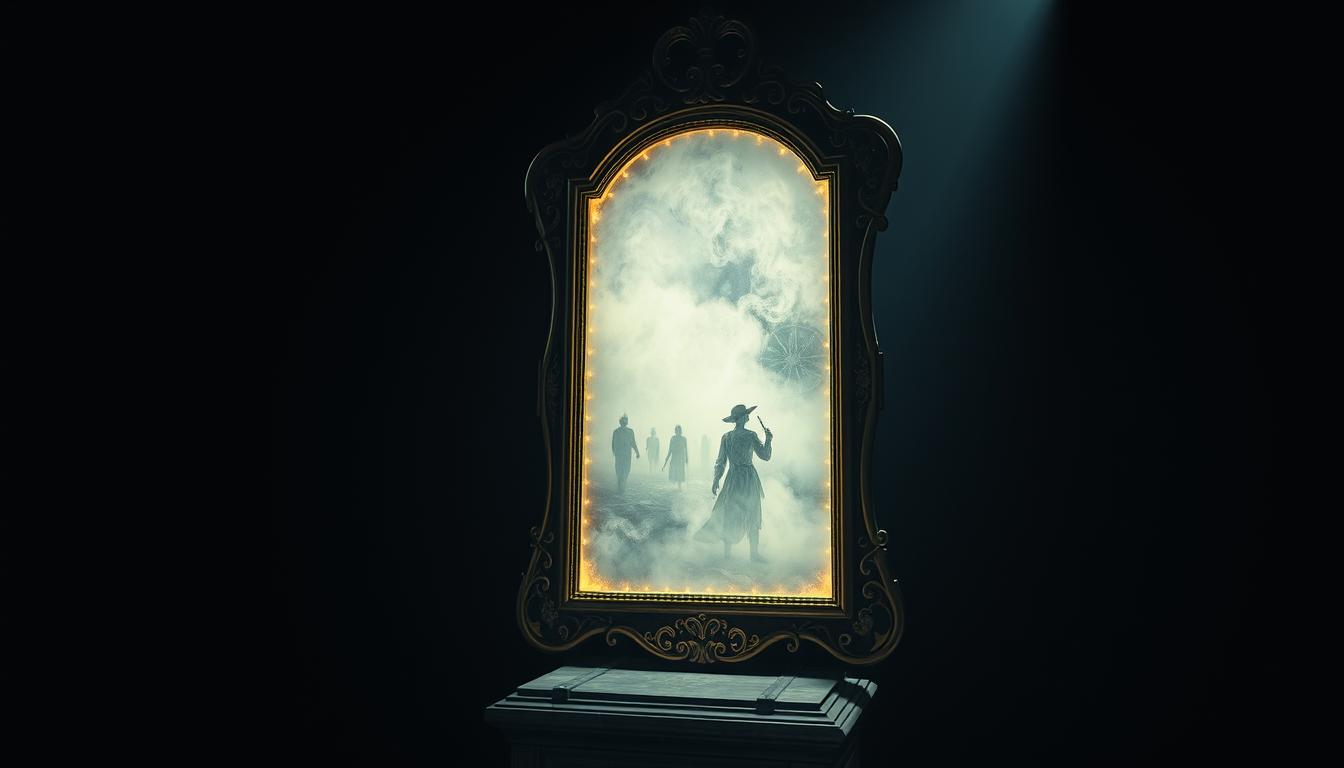Imagine a mirror that shows you a glimpse of history, not your face. The Mirror That Reflects the Past Instead of the Present is more than a dream. It’s a question that has puzzled humans for centuries.
Past-reflecting mirrors mix science with ancient myths, challenging our view of time. Could such a mirror exist? And what secrets would it reveal about our world?

This article dives into why these mirrors fascinate us. We’ll look at their origins, scientific possibilities, and their role in cultures worldwide. Join us to question reality and see how technology and imagination shape our past.
Key Takeaways
- Learn how past-reflecting mirrors merge science and storytelling.
- Discover real-world myths and tech ideas behind temporal reflection mirrors.
- Understand why humans seek connections to history through such mirrors.
- Explore cultural myths and modern innovations shaping this concept.
- See how these ideas challenge our understanding of time and memory.
The Enigmatic Concept of Time-Reflecting Mirrors
For centuries, people have wanted to see beyond today. Time-reflecting mirrors are symbols of this dream. They mix science and myth, making us wonder about seeing the future.
The Fascination with Objects That Bridge Time
Throughout history, objects that hint at time travel have been cherished. Time-bending mirrors are a modern twist on this idea. They make simple reflections into mysteries, blending myth and science.
Mirrors as Portals to Other Dimensions
Legends say mirrors are doors to other worlds. Stories from Japan to Europe tell of spirits appearing in mirrors. Even today, movies like Pan’s Labyrinth show mirrors as portals. Could science one day prove this?
The Line Between Fantasy and Reality
Stories like Alice Through the Looking-Glass show mirrors as doorways to adventure. But science is also exploring time. Neuroscientists and engineers are working on projects that might bring time-reflecting mirrors to life.
Origin Stories and Mythological Roots
Historical reflection objects have always been special in cultures around the world. In ancient Egypt and East Asia, mirrors were more than just shiny surfaces. They were seen as ways to connect with the divine and uncover hidden truths.
- Egypt: Pharaohs thought mirrors could capture souls. They paired the Ankh symbol with reflective bronze discs.
- Greece: The story of Narcissus shows a darker side. His love for his reflection led to eternal stillness, seen as a mirror’s trap between life and death.
- East Asia: In China, mirrors were seen as guardians of spirits. Japanese stories tell of mirrors hiding kami (spirits) in their glass.
Mirror myths also exist in indigenous cultures. Many Native American tribes see mirrors as “eyes of ancestors.” They use them in ceremonies to honor the past. These stories remind us of the deep fears and hopes early societies put into everyday objects.
Today, these tales live on in art, literature, and archaeology. They show our ongoing interest in what mirrors might reveal.
How It Works: The Physics Behind Past-Reflecting Mirrors
Myths and stories are based on science. Scientists study how time and light might interact with materials. They explore theories that connect imagination with physics.
Theoretical Physics Behind Temporal Reflection
Some physicists think time-symmetry in equations could capture past light in mirrors. Einstein’s relativity suggests time is a dimension. But, to store past images, advanced mirror technology is needed. Models like “time crystals” or fields that keep historical light waves are being explored.
The Role of Quantum Mechanics
Quantum reflection suggests particles can hold past states. Here’s how it works:
- Superposition lets particles exist in multiple states, like a mirror holding past and present images.
- Entanglement might link mirror atoms to past light, even seconds ago.
- The observer effect: Looking at a “quantum mirror” could collapse particles into showing a past moment.
Metaphysical Explanations for Past Reflection
“Mirrors are windows to what was, not just what is.” — Indigenous wisdom on metaphysical mirrors
| Aspect | Scientific View | Metaphysical View |
|---|---|---|
| Image storage | Quantum states | Spiritual energy |
| Time interaction | Equations and fields | Portals to ancestral realms |
Science looks for equations, while some cultures see mirrors as bridges to ancestors or parallel worlds. Both paths wonder: Can technology or belief let us see what’s gone?
Cultural Significance Across Different Societies

Cultures around the world have used reflective time objects to connect with their past. These traditions show how societies encode history in everyday items. Let’s look at three global perspectives:
Eastern Philosophies and Time
In Japan, kagami mirrors were thought to hold ancestral spirits. Chinese bronze mirrors had inscriptions to connect the mortal and divine. Buddhist teachings talk about the “mirror mind,” where self-reflection shows past lives. These cultural mirror beliefs highlight Eastern views of mirrors as spiritual gateways.
Western Stories of Reflection
- Shakespeare’s Hamlet uses a mirror as a symbol of truth in the play-within-a-play
- Victorian folklore warned mirrors could trap souls at the stroke of midnight
- Modern sci-fi like Dark Mirror novels explore parallel realities through reflective surfaces
Indigenous Memory Traditions
| Culture | Practice | Example |
|---|---|---|
| Australian Aboriginal | Dreamtime stories | Sacred rock art “mirrors” ancestral journeys |
| Maori | Whakapapa | Mirror-like river surfaces used in genealogy chants |
| Navajo | Silverwork | Traditional mirrors in jewelry to honor ancestral wisdom |
These memory capturing traditions show our shared quest to hold onto moments. Whether through sacred objects or stories, every culture uses reflections to keep what time might erase.
Famous Examples in Literature and Cinema
From books to movies, mirrors in fiction have always shown us hidden truths. These famous fictional mirrors are more than just objects. They are reflective storytelling devices that uncover characters’ deepest fears and dreams.
In J.K. Rowling’s Harry Potter, the Mirror of Erised shows what each person truly desires. Disney’s Snow White has a mirror that says who’s the fairest, showing vanity and power. Jorge Luis Borges’ stories, like “Tlön, Uqbar, Orbis Tertius,” make us question reality through mirrors. Andrei Tarkovsky’s films, like Stalker, use mirrors to reflect deep questions about existence.
- Black Mirror’s “Fifteen Million Merits” uses screens (digital mirrors) to critique modern life, showing how past choices shape futures.
- In Pretty Woman, the mirror scene where Vivian buys a dress symbolizes self-acceptance, blending past insecurities with present courage.
| Work | Mirror’s Role | Psychological Insight |
|---|---|---|
| Harry Potter | Reveals desires | Longing for lost loved ones |
| Snow White | Reflects vanity | Obsession with control |
| Borges’ Labyrinths | Blurs reality | Human search for meaning |
These famous fictional mirrors are more than just plot tools. They are windows into our shared human psyche. Whether in classics or modern media, they ask: What do we see when we stare into the past?
The Psychology of Wanting to See the Past
Our minds often seek the past like a hidden treasure. This section explores why we cling to memories—and how to balance this longing healthily.

Nostalgia as a Driving Force
Research shows nostalgia psychology isn’t just sentimentality. Dr. Clay Routledge’s studies reveal it strengthens identity and social bonds. “Nostalgia anchors us in time,” he explains, noting its role in emotional stability. Yet, overindulgence tips the scale.
Healing Through Historical Reflection
Memory reflection therapy uses past events to mend present wounds. Therapists guide clients to:
- Reframe painful memories as growth opportunities
- Identify patterns to avoid repeating mistakes
When done intentionally, this process builds resilience without trapping individuals in the past.
The Danger of Living in Past Reflections
Past obsession dangers emerge when reflection turns into obsession. Fixating on “the good old days” can block present joy. Clinical studies link chronic rumination to anxiety disorders, urging balance between remembrance and moving forward.
Understanding nostalgia psychology helps us harness its benefits without losing sight of today. After all, the past is a guide—not a cage.
Creating Your Own Metaphorical Past-Reflecting Mirror
Why let the past fade away? Turn daily moments into lasting memories with simple techniques. These methods create a personal gateway to your history, no magic needed.
Journaling and Memory Documentation
Start by grabbing a notebook or opening a note app. Journaling captures the essence of each day. Use prompts like “What surprised you today?” or “What did you learn?” to keep thoughts sharp. Add ticket stubs or pressed flowers for a touch of reality.
Family History Projects
Make family stories last with personal history documentation. Here’s how:
- Interview older family members with questions like, “What was your first job?” Record their voices to keep the emotion alive.
- Make a timeline with dates, photos, and scanned heirlooms. Use apps like Ancestry or Canva to organize.
- Put it all together in a family memory book. Leave space for future generations to add their stories.
Digital Time Capsules
Digital tools like Shutterfly, Capsule, and Google Photos make creating time capsules easy. Here’s how to use them:
- Store videos, voice memos, and social media posts in secure folders.
- Set reminders to check in on your archives every year.
- Encrypt sensitive memories for privacy.
| Tool | Feature | Use Case |
|---|---|---|
| StoryCorps | Guided interview templates | Preserve oral histories |
| Google Photos | AI-driven search | Quickly find date-specific memories |
| Capsule | Timed release dates | Share surprises with future selves |
These methods help you build a mirror of your own. It grows clearer with each entry. Your past is not lost; it’s just waiting to be rediscovered.
The Future of Past-Reflecting Technologies
Humans have always wanted to see the past. Now, new tech is making this dream come true. Let’s see how new technologies might change how we view history.
Emerging Innovations in Memory Capture
Tools like the Narrative Clip and Sony’s Reon Pocket record our lives automatically. They save visual and sensory details, creating digital memories. Startups are working on brain interfaces to turn thoughts into memories we can share.
AI and Its Role in Preserving Personal Histories
AI memory preservation is changing how we remember the past. Eter9’s AI chatbots talk to us like our loved ones did. Apps like MyHeritage use AI to fix old photos and videos. These tools help us organize our family’s history and make memories whole again.
Virtual Reality as Time Travel
Companies like TimeLooper offer VR time travel experiences. They let us step into historical events or special moments from our lives. VR creates 3D models of our childhood homes or family gatherings, making the past feel real.
These technologies show our deep desire to go back in time. Whether it’s AI, VR, or wearable devices, the future is full of possibilities. Tomorrow’s “mirrors” might show us more than we can imagine, one innovation at a time.
FAQ
What exactly is a time-reflecting mirror?
A time-reflecting mirror is a thought-provoking idea. It suggests a mirror could show us the past, not just the present. This idea blends technology, metaphysics, and psychology, sparking our curiosity.
How do cultural beliefs influence perceptions of mirrors?
Different cultures see mirrors as more than just glass. In ancient Egypt, they were seen as portals to other worlds. In Eastern traditions, mirrors are spiritual tools. These views shape our understanding of mirrors and time.
What scientific theories support the concept of mirrors reflecting the past?
Theories in physics and quantum mechanics offer clues. Ideas like quantum entanglement and time-symmetry hint at capturing past images. Yet, these ideas are still speculative and complex.
Can nostalgia be beneficial for mental health?
Yes, nostalgia can be a powerful emotional tool. Studies show it can bring us closer to our past, fostering connection and healing. But, it’s important to stay present too.
What are some creative ways to preserve memories?
You can create your own past-reflecting mirror through journaling or family history projects. Building digital time capsules is another way to document your experiences for the future.
How is technology evolving to reflect past experiences?
Technologies like AI, lifelogging cameras, and virtual reality are changing how we remember. They offer immersive experiences that feel like time travel, opening up new possibilities.
What ethical considerations should we keep in mind regarding memory preservation?
As tech improves in saving our memories, we must think about ethics. Privacy and consent are key. We must use these technologies responsibly and with respect.
